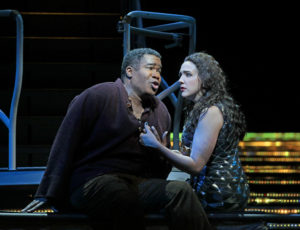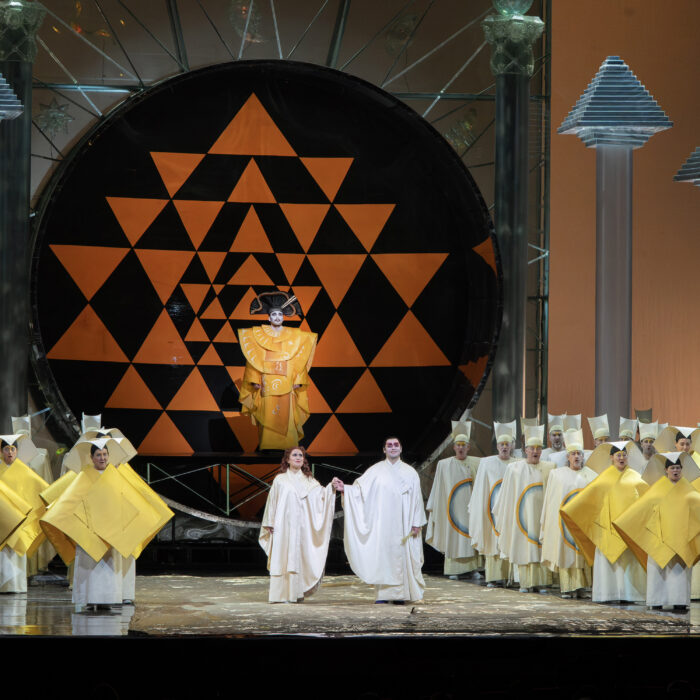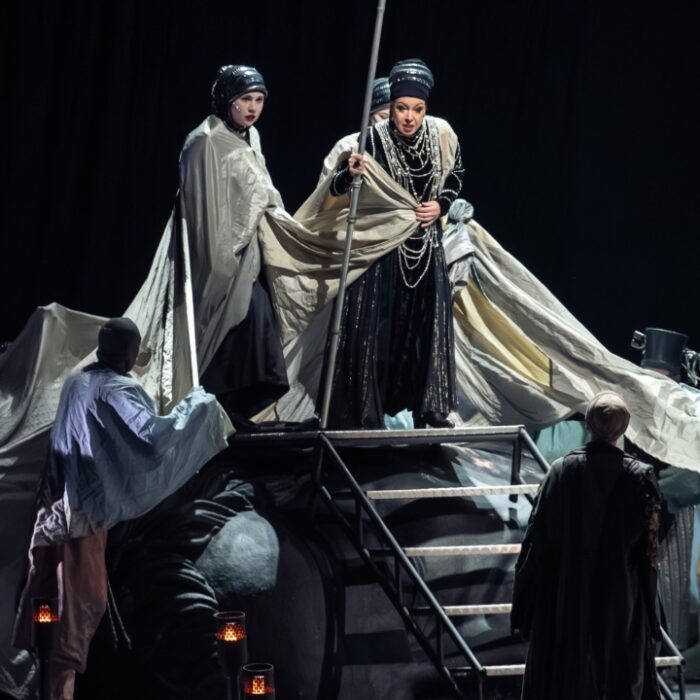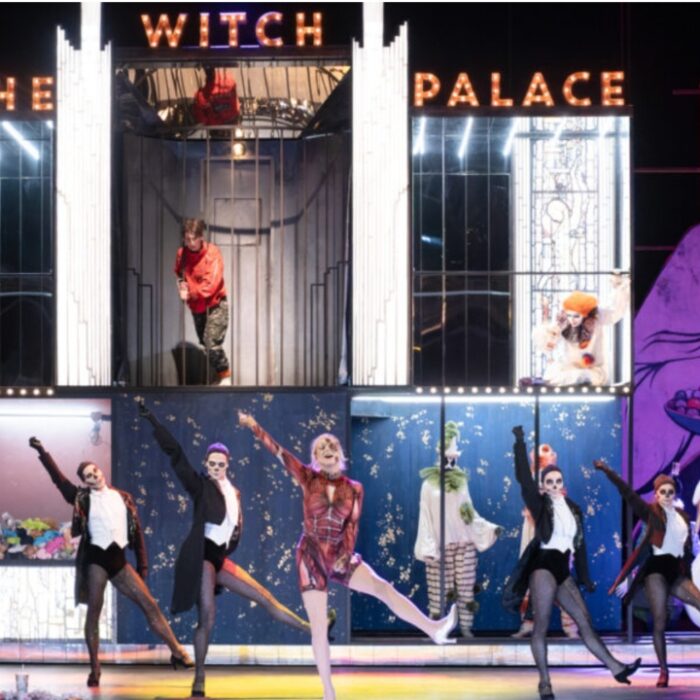
Metropolitan Opera Review 2016-17 – L’Amour de Loin: Singers Provide Light Despite a Strange Dark Moment in Saariaho’s Masterpiece
By David SalazarThis article relates to the performance of “L’Amour de Loin” at the Metropolitan Opera on Dec. 14, 2016.
There was a light show on the stage of the Metropolitan Opera House on Wednesday evening in the company’s performance of Kaija Saariaho’s “L’Amour De Loin,” though a sudden moment of darkness threatened to be the most impactful moment of the entire evening.
In the middle of the first half of the modern work, the curtain came down, the brilliant light show on stage went black and suddenly, the audience was greeted by the stage manager to hear some interesting news – that a malfunction to the production was delaying the continuation of the performance.
Not particularly surprising. Technical glitches come with the territory of putting on a production.
But the context is key, because of whose production it was.
A History of Malfunctioning Productions
Robert LePage is a visionary. He is brilliant when it comes to figuring out how to combine technology with stagecraft to create some pretty potent visuals. He creates elaborate machines to aid his cause, but those very creations have the propensity for breaking down in the middle of performances and this situation on Wednesday seems to be more of an expectation at this point than an anomaly when it comes to a LePage production. Few will forget when the famed Ring Machine shut down at its big inauguration. Or subsequent technical failures it endured throughout its opening nights and subsequent runs of Wagner’s glorious tetralogy. Even the “La Damnation De Faust” production, arguably his finest at the Met to date, had some technical backfires on one evening that this writer witnessed.
So hopefully all issues are nipped in the bud, and any potential technical glitches have been studied and done away with so that nothing similar happens at subsequent performances.
Because to be quite frank, if not for that dark moment, the performance of the Saariaho work would have been perfect.
A True Operatic Masterpiece
The opera itself is a gem, albeit a complex one that takes some time to not only experience but then to digest. In many ways it appeals to the intellect as much, if not more so, than it does to the emotions. The narrative is straightforward. A Prince has been singing to an idealized love from afar. He discovers that this woman does in fact exist and when she hears of his singing to her, she too falls for him. But the two have one major trepidation – what if their idealized passion implodes upon meeting one another and seeing their respective flaws. The opera ruminates on this question of love, its answer no less conclusive as the Prince dies when he meets his beloved, an implication or suggestion that their love can only be preserved by his death and the continued idea of what could be rather than what is.
The music, created by only the second female composer in the company’s history, takes us to a distant world, engulfed with shimmering string instruments and constant mode shifts that keep us in suspension. The early acts give off an ambience of common and mystery with the orchestra’s first major emotional outburst coming about 40 minutes in and really shake the listener out of the fantasy that he or she has been transported to. As the work unravels and the characters draw closer to each other, the music itself become smore temperamental, the emotional outbursts from the orchestra more and more constant, the chorus taking on a more aggressive tone toward the main characters. There is a rich emotional journey at work here, though it may not be immediately apparent.
Spotlight Taken By Singers
And the singers truly brought it to life. With a light show swarming around them and their space limited on stage (Tamara Mumford pretty much stays in a boat for the duration while Eric Owens and Susanna Phillips move from the boat to a massive crane-like ladder on a dolly that is equally restrictive), the singers still stole the spotlight with incredible vocal displays.
Susanna Phillip’s sang the role of the Countess with a silky tone, many of her high notes taking on a disembodied feel without the vibrato. But her role also showcased tremendous emotional range, with the countess subject to great emotional outbursts that ranged from exhilaration to enchantment to downright fury and frustration. At the end of the second half of the work, she ponders whether the Prince would still love her if he saw her many faults. Phillips’ pauses in this moment add to the reflective nature of the scene, her voice taking on a delicate complexion that matched the emotional vulnerability of the character. Her greatest triumph came in that final scene, where she allowed her voice to dig deep into the lower register and pull out all the anger and pain of losing her beloved. In one blasphemous moment, she shouted at God for abandoning her or ignoring her; a moment of unabashed anger that resonated emotionally more than any other moment in the entire evening.
Owens’ voice had an earthy quality throughout, though it took on a far sweeter quality in certain scenes, most memorably when he utters the name “Clemence” repeatedly. His legato throughout was polished, perfectly embodying the troubadour Prince.
As the go-between was Tamara Mumford as the Pilgrim, her vocal style also taking from both. At times she would sing with the same edge as Owens, particularly when she trilled (she is asked to trill throughout the opera). At other times, her voice took on a suave quality, a fluidity that matched the Countess’ finessed sound world.
In the pit was Susanna Malkki, the fourth ever female conductor in the company’s history. She created a wondrous ebb and flow throughout the piece, particularly at the start of both sections of the work. In the opening prelude, the arrival of the different pitches (matched quite splendidly onstage with lights cropping up from darkness) gave the listener a slow approach into the aural landscape. The second half’s opening orchestra passage created an ebb and flow that allowed the listener to truly feel in the rapture of a tumultuous ocean.
Final Consideration on LePage’s Production
Le Page’s production offers up some unique visuals, particularly in the fourth act’s dream sequence with a ballerina diving in and out of the water. The choice of a black lightscape also adds to the sense of mystery one experiences in dreams. Throughout the rest of the evening, the different shades of blue give the sense of a vast ocean while one moment of red emulates the sunset quite poignantly. The depiction of the chorus, their heads come up through the lights was also quite imposing, giving them a spiritual resonance.
Technical malfunctions aside, “L’Amour De Loin” is a work to be celebrated. Not only is it progressive on a social front for the company, but taken at face value, it is the demonstration of what opera is and could be at its highest form. Not only is Saariaho’s music profound and enriching, but it creates a desire for a repeat listen from the audience member, if only to plunge deeper and unlock more of its hidden treasures. Coupled with a thought-provoking libretto and a strong cast, this opera is truly enlightening.


